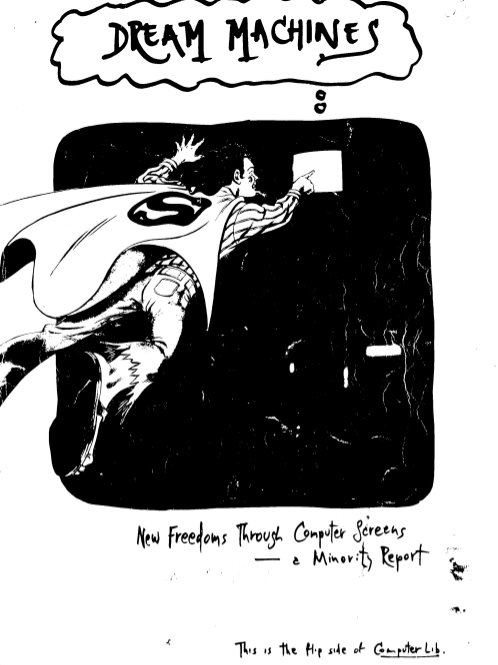Ted Nelson: Computer Lib / Dream Machines (1974)
Filed under book | Tags: · computing, hardware, history of computing, history of technology, manifesto, media history, software, technology


“Computer Lib is a book by Ted Nelson, originally published in 1974 by Nelson himself, and packaged with Dream Machines, another book by Nelson. The whole publication (referred to as just “Computer Lib” by Nelson and others) had two front covers to indicate the “intertwingling” of the two books, and was republished with a foreword by Stewart Brand in 1987 by a division of Microsoft Press. The book, which is subtitled “You can and must understand computers NOW,” and which Nelson says in the 1987 edition was inspired by Brand’s Whole Earth Catalog, is a spirited manifesto that was inspiring to a generation of DIY computer-lovers. In his book Tools for Thought, Howard Rheingold calls Computer Lib “the best-selling underground manifesto of the microcomputer revolution.”
In Computer Lib, Nelson writes passionately about the need for people to understand computers deeply, more deeply than was generally promoted as “computer literacy,” which he considers a superficial kind of familiarity with particular hardware and software. His rallying cry “Down with Cybercrud” is against the centralization of computers such as that performed by IBM at the time, as well as against what he sees as the intentional untruths that “computer people” tell to non-computer people to keep them from understanding computers.
In Dream Machines, Nelson covers the flexible media potential of the computer, which was shockingly new at the time.” (from Wikipedia)
Publisher Hugo’s Book Service, 1974
132 pages
Reviews: d.h.f. (Byte Magazine, 1975), L.R. Shannon (New York Times, 1988), Vince Juliano (Connecticut Libraries, 1996).
Commentary: Noah Wardrip-Fruin (2003).
Book website
Author
Wikipedia
More information and reviews
PDF (15 MB, updated on 2021-7-9)
Comments (4)Mercedes Bunz: Vom Speicher zum Verteiler: Die Geschichte des Internet (2008) [German]
Filed under book | Tags: · arpanet, computing, filesharing, history of computing, history of technology, internet, media history, media theory, networks, technology

Das Internet ist kein Speichermedium, es ist ein Verteilungsmedium. Deshalb ist nichts im Internet so beständig wie der Wandel – und das ist von Beginn an so gewesen. Schon in den sechziger Jahren wird die Vernetzung von Computern zugleich als Einkaufsmöglichkeit, als Austausch von Forschungen und als Sicherstellen durch verteilte Kommunikation nach einem Bombenangriff entworfen. Damit wird der Fokus bei diesem Medium immer wieder auf Schnelligkeit und Dynamik und nicht auf seine Beständigkeit gelegt.
Von diesen frühen Planungen der ersten Netzwerke bis hin zum heutigen Internetprotokoll verfolgt das vorliegende Buch die Entstehung und den Wandel dieser Technologie und stellt die wichtigsten Projekte, Visionäre und Ingenieure der Geschichte des Internet vor. Dabei zeigt sich auch: Die Entstehung dieser Kulturtechnik hat keineswegs nur in Amerika stattgefunden. Die Geschichte des Internets entspringt nicht einem Ort, sie folgt vielmehr seiner eigenen Architektur und ereignet sich selbst in Form eines verteilten Netzwerkes. Im Erzählen seiner Geschichte gilt es deshalb auch, einen Paradigmenwechsel zu vollziehen. Weil der Fokus dieses neuen Mediums auf dem Verteilen und nicht auf dem Speichern liegt, ist die Geschichte des Internet im besonderen Maße auch eine Herausforderung für das Denken einer zeitgenössischen Medientheorie.
Publisher Kulturverlag Kadmos, Berlin, February 2008
copyrights Bd. 20
ISBN 3865990258, 9783865990259
147 pages
PDF (updated on 2012-7-25)
Comment (1)Tim Wu: The Master Switch: The Rise and Fall of Information Empires (2010)
Filed under book | Tags: · history of technology, industry, internet, media history, politics, technology

In this age of an open Internet, it is easy to forget that every American information industry, beginning with the telephone, has eventually been taken captive by some ruthless monopoly or cartel. With all our media now traveling a single network, an unprecedented potential is building for centralized control over what Americans see and hear. Could history repeat itself with the next industrial consolidation? Could the Internet—the entire flow of American information—come to be ruled by one corporate leviathan in possession of “the master switch”? That is the big question of Tim Wu’s pathbreaking book.
As Wu’s sweeping history shows, each of the new media of the twentieth century—radio, telephone, television, and film—was born free and open. Each invited unrestricted use and enterprising experiment until some would-be mogul battled his way to total domination. Here are stories of an uncommon will to power, the power over information: Adolph Zukor, who took a technology once used as commonly as YouTube is today and made it the exclusive prerogative of a kingdom called Hollywood . . . NBC’s founder, David Sarnoff, who, to save his broadcast empire from disruptive visionaries, bullied one inventor (of electronic television) into alcoholic despair and another (this one of FM radio, and his boyhood friend) into suicide . . . And foremost, Theodore Vail, founder of the Bell System, the greatest information empire of all time, and a capitalist whose faith in Soviet-style central planning set the course of every information industry thereafter.
Explaining how invention begets industry and industry begets empire—a progress often blessed by government, typically with stifling consequences for free expression and technical innovation alike—Wu identifies a time-honored pattern in the maneuvers of today’s great information powers: Apple, Google, and an eerily resurgent AT&T. A battle royal looms for the Internet’s future, and with almost every aspect of our lives now dependent on that network, this is one war we dare not tune out.
Part industrial exposé, part meditation on what freedom requires in the information age, The Master Switch is a stirring illumination of a drama that has played out over decades in the shadows of our national life and now culminates with terrifying implications for our future.
Publisher Alfred A. Knopf, 2010
Borzoi Books
ISBN 0307269930, 9780307269935
366 pages
review (Peter Decherney, Nathan Ensmenger, Christopher S. Yoo)
PDF (EPUB; updated on 2012-7-16)
Comment (0)
